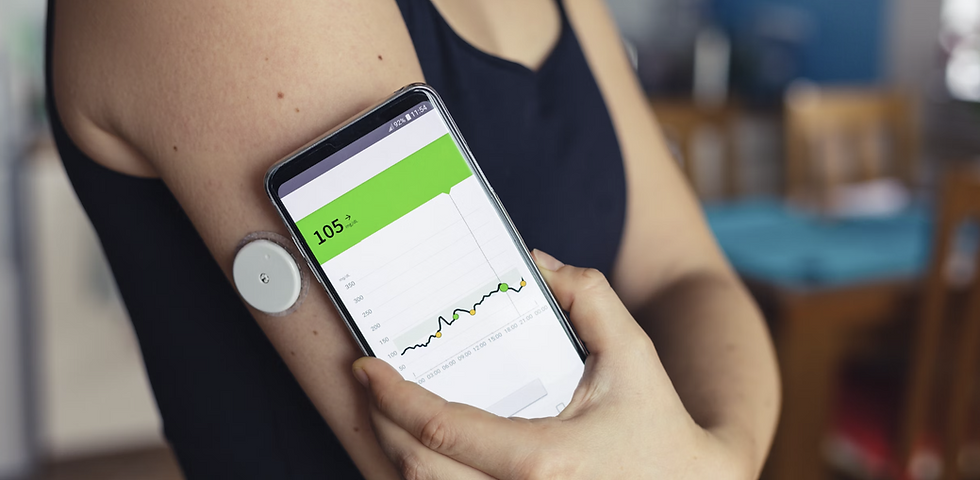Wearing a CGM Without Diabetes—Smart Move or Too Much Data?
- Elane Bosman

- Jul 24
- 4 min read

Are They Useful for Early Prevention, or Unnecessary and Anxiety-Inducing?
Continuous glucose monitors (CGMs) were originally developed to help people with type 1 or insulin-dependent type 2 diabetes monitor their blood sugar levels in real time. But over the last few years, CGMs have become increasingly popular among non-diabetics, health-conscious individuals, athletes, and those at risk of insulin resistance or metabolic syndrome.
The question is: Are CGMs valuable tools for early detection and metabolic optimization—or are they overhyped, costly, and potentially anxiety-inducing for people without diabetes?
Let’s explore the clinical evidence and functional medicine perspective.
What Is a Continuous Glucose Monitor (CGM)?
A CGM is a wearable device that tracks interstitial glucose levels 24/7. It typically consists of:
A small sensor inserted under the skin (usually on the arm or abdomen)
A transmitter that sends glucose readings to a smartphone or receiver every few minutes
Unlike finger-stick testing, which offers a single glucose value at a specific point in time, CGMs provide a dynamic, real-time view of glucose patterns throughout the day and night, including responses to meals, exercise, stress, and sleep.
Why Would a Non-Diabetic Use a CGM?
Even in the absence of a formal diagnosis, many individuals experience glucose variability, reactive hypoglycemia, or early insulin resistance long before conventional lab markers like fasting glucose or HbA1c reflect dysfunction.
CGMs offer a unique opportunity to observe:
Post-meal glucose spikes
Glycemic variability (how much glucose fluctuates)
Nocturnal dips or elevations
Impact of specific foods, stress, and sleep quality
Clinical and Functional Benefits of CGM in Non-Diabetics
1. Early Detection of Metabolic Dysfunction
A person may have normal fasting glucose and HbA1c, yet experience high post-meal spikes or exaggerated glucose swings. These patterns may precede prediabetes by years.
A 2020 study in Diabetes Spectrum found that 15–20% of normoglycemic individuals had abnormal postprandial glucose excursions detectable by CGM, even when their standard lab tests were normal.
Reference: Castle JR et al., Diabetes Spectrum, 2020.
2. Improved Nutritional Awareness
CGMs help individuals understand how specific foods impact their blood sugar, often revealing surprising results:
Whole-grain bread causing sharp spikes
Some fruits being well tolerated
High-fat meals producing delayed glucose elevations
This feedback supports personalized nutrition—a core principle in functional medicine.
3. Enhanced Insulin Sensitivity through Real-Time Behavior Change
By reducing glucose spikes through food timing, macronutrient pairing, and movement, users can reduce their overall glycemic variability, which is associated with:
Improved mitochondrial function
Reduced inflammation
Lower cardiovascular risk
A study in The Lancet (2021) showed that reducing post-meal glucose excursions improved endothelial function, even in non-diabetic individuals.
Reference: Monnier L et al., The Lancet Diabetes & Endocrinology, 2021.
4. Motivational Biofeedback
Real-time glucose data can motivate individuals to:
Walk after meals
Choose lower-glycemic meals
Sleep earlier
Reduce alcohol or sugar intake
This immediate reinforcement can increase long-term adherence to lifestyle changes.
The Downsides and Potential Risks
1. Data Overload and Health Anxiety
Some users may experience hyper-vigilance, especially when every glucose fluctuation is interpreted as “bad.” In non-diabetics, temporary spikes after meals are normal and expected.
Without clinical guidance, users may unnecessarily restrict healthy carbohydrates, develop fear-based eating patterns, or feel confused by normal variations.
2. Cost and Accessibility
CGMs can be expensive—especially without a diabetes diagnosis or insurance coverage. This may not be feasible for long-term use, especially if not paired with professional guidance.
3. Misinterpretation Without Context
CGM data must be interpreted in context:
A glucose spike to 135 mg/dL after a carb-rich meal may be completely normal and resolve quickly.
A small spike might be interpreted as “dangerous” by someone lacking a clear understanding of glucose physiology.
Functional and integrative practitioners emphasize that one number doesn’t determine health—it’s the pattern, magnitude, and recovery that matter.
Who May Benefit Most from CGM (Even Without Diabetes)?
From a clinical and functional standpoint, CGMs may be most valuable for:
Individuals with prediabetes, metabolic syndrome, or family history of type 2 diabetes
People with polycystic ovary syndrome (PCOS) or non-alcoholic fatty liver disease (NAFLD)
Those experiencing unexplained fatigue, brain fog, or cravings
Athletes or biohackers optimizing performance and recovery
Individuals undergoing major dietary change (e.g., low-carb, keto, intermittent fasting)
Patients trying to reverse insulin resistance or improve fertility through nutrition
Integrative Clinical Takeaway
CGMs can be a powerful tool when used:
With clear goals
For a defined period of time (e.g., 2–4 weeks)
Alongside professional support from a healthcare provider, nutritionist, or health coach
They are not a replacement for clinical judgment or metabolic testing, but rather a complement—providing real-time feedback to refine dietary and lifestyle choices.
Final Thoughts
For non-diabetics, CGMs are not essential—but they can be highly informative, particularly for early detection and behavior change.
They offer a unique window into real-time metabolic function, helping patients understand how their choices affect their biology—meal by meal, day by day. However, without context and guidance, they may lead to confusion or unnecessary dietary restriction.
As with any tool, the key is how you use it.
For individuals at risk of metabolic dysfunction—or those motivated to optimize their health—CGMs can turn abstract nutritional advice into concrete, personalized action.




Comments